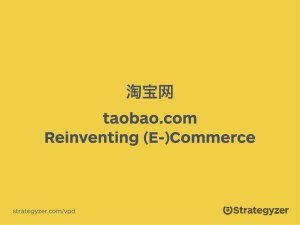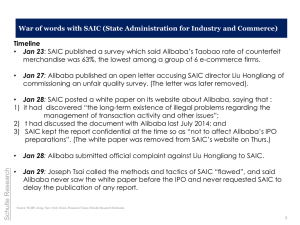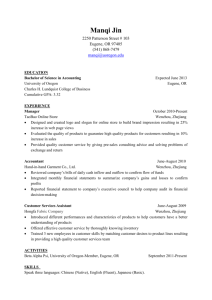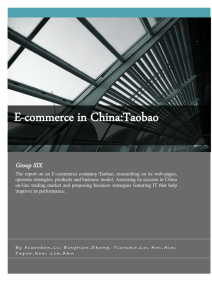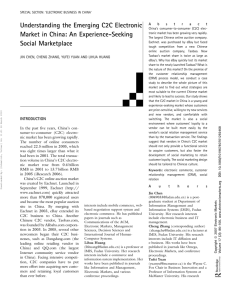2010: Taobao & Chinaʼs “Me-Commerce” Revolution
advertisement
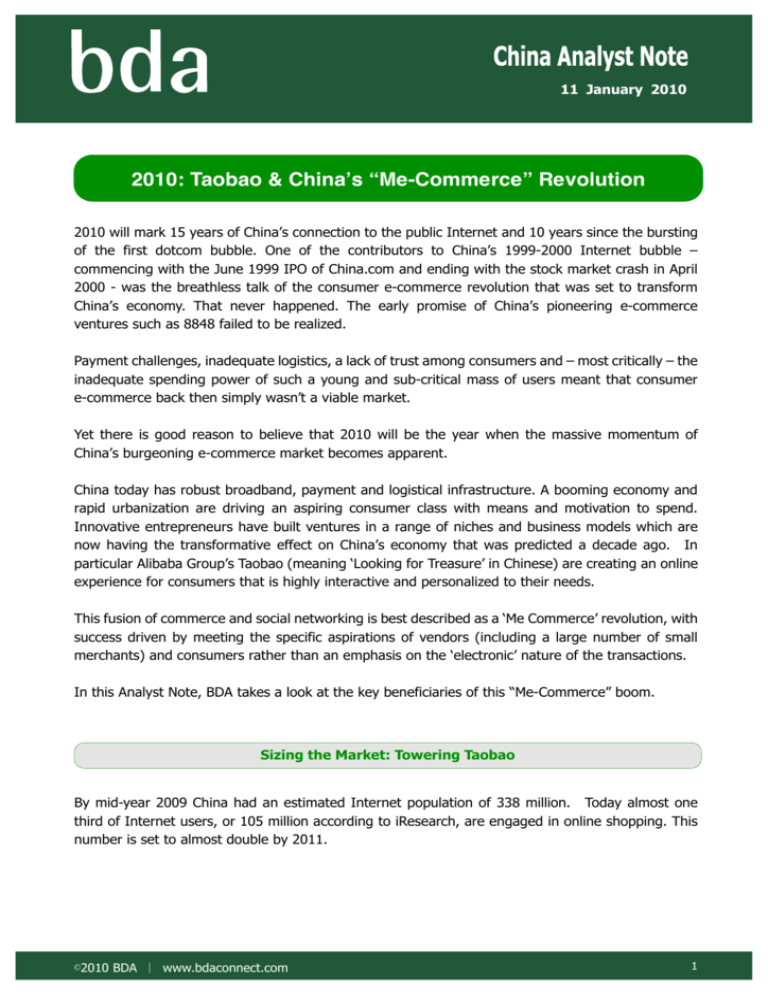
11 January 2010 2010: Taobao & Chinaʼs “Me-Commerce” Revolution 2010 will mark 15 years of China’s connection to the public Internet and 10 years since the bursting of the first dotcom bubble. One of the contributors to China’s 1999-2000 Internet bubble – commencing with the June 1999 IPO of China.com and ending with the stock market crash in April 2000 - was the breathless talk of the consumer e-commerce revolution that was set to transform China’s economy. That never happened. The early promise of China’s pioneering e-commerce ventures such as 8848 failed to be realized. Payment challenges, inadequate logistics, a lack of trust among consumers and – most critically – the inadequate spending power of such a young and sub-critical mass of users meant that consumer e-commerce back then simply wasn’t a viable market. Yet there is good reason to believe that 2010 will be the year when the massive momentum of China’s burgeoning e-commerce market becomes apparent. China today has robust broadband, payment and logistical infrastructure. A booming economy and rapid urbanization are driving an aspiring consumer class with means and motivation to spend. Innovative entrepreneurs have built ventures in a range of niches and business models which are now having the transformative effect on China’s economy that was predicted a decade ago. In particular Alibaba Group’s Taobao (meaning ‘Looking for Treasure’ in Chinese) are creating an online experience for consumers that is highly interactive and personalized to their needs. This fusion of commerce and social networking is best described as a ‘Me Commerce’ revolution, with success driven by meeting the specific aspirations of vendors (including a large number of small merchants) and consumers rather than an emphasis on the ‘electronic’ nature of the transactions. In this Analyst Note, BDA takes a look at the key beneficiaries of this “Me-Commerce” boom. Sizing the Market: Towering Taobao By mid-year 2009 China had an estimated Internet population of 338 million. Today almost one third of Internet users, or 105 million according to iResearch, are engaged in online shopping. This number is set to almost double by 2011. 2010 BDA ∣ www.bdaconnect.com 1 Exhibit 1: China’s Online Shopping Users (million, 2007-2011F) Source: iResearch & BDA analysis Sales generated from these shoppers are set to grow rapidly. iResearch forecasts the market to grow from RMB 190 billion (USD 28 billion) in 2009 to over RMB 400 billion (USD 60 billion) in 2011. By comparison the consumer e-commerce market in the US in 2008 totaled USD 178 billion. Exhibit 2: China’s Online Shopping Market (RMB billion, 2007-2011F) 406 B2C 2007-2011 CAGR: 64% 280 189 C2C 109 56 Source: iResearch & BDA analysis Alibaba Group’s Taobao unit indicates that iResearch’s data is conservative. BDA believes Taobao accounts for over 80% of the consumer e-commerce market, trailed far behind by Tencent’s Paipai and eBay/Eachnet each with less than 10% in 2008. Baidu’s Youa contender was 2010 BDA ∣ www.bdaconnect.com 2 only launched in 2008 and has yet to make an impact. Taobao’s massive lead is reflected in the number of goods offered on its site – over 200 million vs. less than 20 million items from its rivals. Exhibit 3: Selected E-Commerce Contenders: Taobao & The Rest E-commerce Contenders Logo Launch Date in China Parent Estimated 2008 Market Share Taobao 2003 82.1% Paipai 2006 9.9% Eachnet 2002 8.0% Youa 2008 N/A Source: iResearch, Company information Taobao is estimated to have a Gross Merchandise Volume (GMV) of RMB 100 billion (USD 15 billion) in 2008. This is thought to have doubled in 2009 to RMB 200 billion (USD 30 billion). Mid 2009, Taobao claimed 143 million registered users or 43% of the Internet population, although a more useful datapoint is the number of active users - 30% of the total, or c. 47 million - which Taobao defines as those purchasing on their site at least once within the last six months. By comparison, eBay recorded 86.3 million active users worldwide at year end 2008. Taobao’s assertion of RMB 100 billion GMV in 2008 would already put it at c. 19% of eBay’s 2008 overall GMV, or as much as 75% of eBay’s non-vehicle GMV in the US. Of course GMV is not itself an indicator of profitability of an e-commerce provider, but reasons for optimism in Taobao’s trajectory will be explored in an analysis of the company’s business model – driven by advertising - detailed below. What’s Selling Online? China’s consumer e-commerce segments of most promise in China include areas such as books & audio-visual content, apparel, babycare, consumer electronics and IT. Books and a/v content, in China as in the US, are well suited to online sales and lie behind the success of China’s ecommerce ‘survivors’. Both founded a decade ago, Dangdang and Joyo (since 2004 a unit of Amazon.com) continue to dominate their segment with sales of approximately RMB 1.5 billion (USD 220 million) in 2009. Substantial potential remains in this category as online books sales in China still account for under 8% of China’s total non-textbook publishing market, vs. over 2010 BDA ∣ www.bdaconnect.com 3 20% in the US. Beyond books, music and video, Taobao’s top 10 product categories in 2008 are a good proxy for the overall shape of the consumer e-commerce market. Exhibit 4: Taobao’s Top 10 Product Categories in 2008 Transaction Volume in 2008 Ranking Products 1 Apparel 16.0 2 Handsets 10.8 3 Cosmetics 5.6 4 Basic daily items 5.6 5 Outdoor 5.4 6 PC hardware 5.2 7 Jewelry 5.0 8 Laptops 4.9 9 Small home appliances 3.8 10 Telecom prepaid cards 3.7 (RMB Billion) Source: Company data, BDA interviews Behind each product category there is a range of specific factors driving online sales. “China-specific” features need to be considered, which explain why some categories online thrive in China but not in the US or other developed markets. For mobile phones, the availability of smuggled (for example iPhones with WiFi functionality not available locally, or “shanzhai” ‘bandit’ phones) or 2nd hand handsets drives sales on Taobao, which claims 10% of all handsets sold in China this year. For cosmetics, cutting out the cost of a physical retailer makes online goods substantially cheaper than offline. For apparel, consumers may choose to buy (knowingly) fake goods of decent enough quality, widely available in China given its massive manufacturing output, or look for niche clothing such as baby clothes not easily available in their local stores, especially in Tier 2 or Tier 3 cities. In addition to Taobao and other general contenders, niche sites are exploiting growth in the above listed areas as well as other promising categories including health products, housing-related products and services (ranging from home improvement to apartment rentals) and food/dining related services. There are scores of sites emerging across these categories, ranging from large players likely to IPO in 2010 to niche profitable sites that are set to see sustained organic growth. Examples include 360Buy which focuses on “3C” (consumer, communication and computer) products which it sells at prices approximately 10% cheaper than physical retailers Gome and Suning. The company targeted 2009 revenues of over USD 500 million, and projects a 100% growth rate in 2010. Housing/rental site Telstra-controlled Soufun forecast revenues in excess of USD 50 million in 2009. At the lower end of the scale Diamond retailer Popdiamond is an example of a smaller retailer with reported sales in 2009 2010 BDA ∣ www.bdaconnect.com 4 of c. USD 5 million which is enjoying high margins. How Are Things Sold Online? Chinese e-commerce behavior is very different from the US. EBay in the US generates roughly half of its GMV through auction-style transactions. In China, auctions on Taobao are less than 5% of GMV, as Chinese consumers prefer to buy new things at fixed prices than bidding for used items in an auction. This reflects to some extent supply: the availability of new products churned out by Chinese manufacturers – including presumably some goods which, pre-financial crisis, would have found buyers overseas. Buying new also reflects demand: the desire by Chinese consumers for new things, and generally low levels of trust/expectation amongst Chinese consumers buying from each other. Success for any e-commerce player in China involves finding the successful formula for addressing trust question along every step of the transaction chain. Exhibit 5: Taobao’s Online Transaction Value Chain Step 4 Delivery: Third party logistics companies List products, set prices, Step Buyers process order 2 Browse products, order products Communicate with Ali Wangwang Communicate with Ali A C2C Step 1 Sellers Wangwang Platform Payment: Alipay Step Source: Taobao 3 Taobao has clearly found the right mix. Taobao provides a platform where sellers can list products, set prices and process orders online, while buyers can browse and purchase online. Crucial to the smooth functioning of the site is the credit evaluation mechanism that establishes trust between buyers and sellers by giving the ability of trading partners to reward or punish as needed behavior of their counterparts. Interactive communications are an essential part of facilitating transactions, with 60% of all Taobao users employing Ali Wangwang, a messenger service (operating online, mobile, MMS, video chat) tailored for Taobao and enhancing the site’s network effect. Alibaba Group’s Alipay unit provides a payment safety guarantee for buyers and sellers which facilitates 80% of Taobao’s GMV. Taobao recommends reliable logistics companies to users as the final step in the vendor/purchaser/payment/delivery transaction chain. 2010 BDA ∣ www.bdaconnect.com 5 To compete, independent e-commerce providers need to benchmark their prices or user experience to Taobao, partnering as needed with search, payment, logistics companies to meet consumer expectations. Revenue Models: From Volume to Value While it is clear that there is huge volume now on Taobao and a growing number of niche sites, how do these providers get their cut? In the case of eBay in the US transaction commissions represent c. 90% of the revenues of the company (USD 4.7 billion in 2008) with other items such as hosting fees or advertisements the remaining 10%. In China, eBay had built a presence since 2002 through its investment and absorption of Eachnet. Taobao was a relative latecomer to the market – founded by Alibaba in 2003 – yet succeeded in rapidly taking on, and humiliating, eBay in this market by adopting a ‘free of charge’ strategy to compete with Eachnet’s listing fee model. How then to make money? The answer is advertising. Taobao’s traffic makes it (according to Alexa.com) already the 5th largest website in China behind Baidu, QQ (Tencent), Sina and Google’s Chinese site. Over 80% of Taobao’s c. USD 300 million estimated 2009 revenues came from advertising, mostly ‘pay for performance’ ads as well as ‘pay for transaction’ and brand advertisements. The remaining 20% of revenues were generated between commissions that Taobao charges on its new (launched in 2008) Taobao Mall – a B2C area within its C2C platform – and value added services for merchants. Of course not (yet) charging transaction fees means that the “take rate” of Alibaba – the revenue generated for the company vs. the GMV – is only c. 1% vs 7.9% in the case of eBay, but this also explains the rapid increases in the GMV and the barriers for other contenders to take on Taobao. 2010 Outlook While detailed financials on Taobao are not yet publicly available, BDA believes the company to have reached break-even in late 2008 and performance in 2009 gives the company’s the momentum needed for an IPO this year should Alibaba Group decide that market conditions are ripe. Should an IPO happen we can anticipate the same frenzied scenes in Hong Kong that accompanied the company’s 2007 B2B IPO of Alibaba.com. Investor anticipation of this event is likely to give room to a number of other profitable e-commerce ventures to come to market, and set the scene for 2010 as the year of China’s “Me Commerce” revolution. 2010 BDA ∣ www.bdaconnect.com 6 For comments or questions, please contact feedback@bdaconnect.com About BDA BDA is the leading advisory firm serving companies in Asia’s telecommunications, media and technology (TMT) sectors and private equity firms in TMT and other fast-growing sectors. With a track record of 15 years in Asia, BDA has successfully guided the strategies of industry participants and investors since its establishment in 1994. Our teams of China- and India-based professionals are located at the heart of Asia’s growth engines and specialize in dealing with challenging regulatory situations and highly competitive markets. For more information about our people, our company, and our services, please visit www.bdaconnect.com or call us in Beijing at +8610 8529 6164. 2010 BDA ∣ www.bdaconnect.com 7
